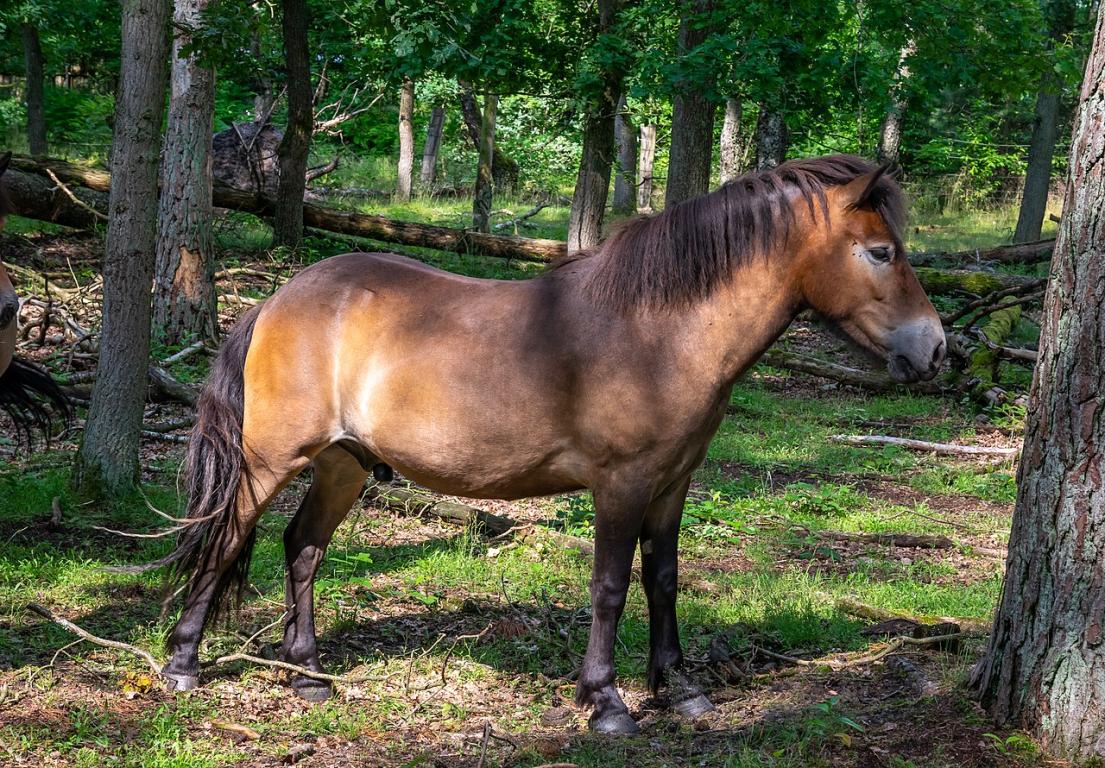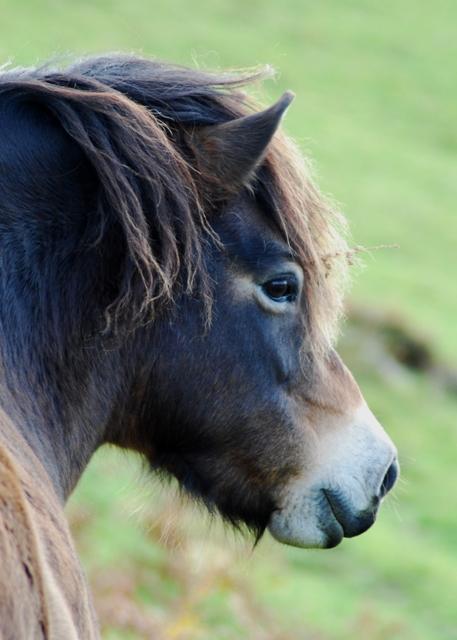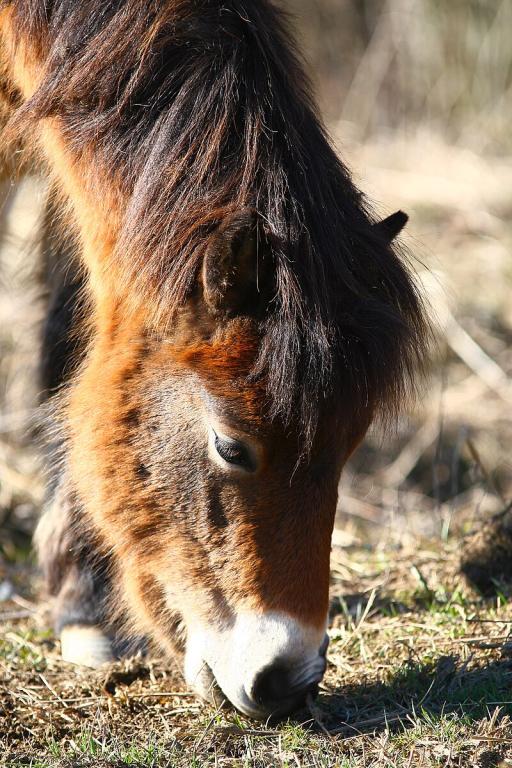
Continent: Europe
Country: United Kingdom
Weight: 250 – 350 kg
Height: 116 – 129 cm


The Exmoor Pony originates from the south-west of England, more precisely from the rugged and windswept Exmoor National Park, straddling the counties of Somerset and Devon. This landscape of moorlands, valleys and peat bogs is marked by a harsh oceanic climate, with wet winters, strong winds and sparse vegetation.
Considered one of the oldest and most primitive equine breeds in Britain, the Exmoor shows morphological traits close to those of prehistoric wild ponies depicted in cave art.
Historically, these ponies lived in semi-freedom and were locally used as pack animals, for light farm work, and as children’s mounts.
Culturally, the Exmoor Pony is a strong symbol of the rural identity of Devon and Somerset, often associated with the traditional British moorland landscapes and with the conservation of local wildlife and flora.
The Exmoor Pony is closely linked to the Exmoor moorlands, located between Devon and Somerset in the south-west of England. It is within these isolated natural areas, marked by wind-swept plateaus, sparse vegetation and a harsh climate, that the breed has evolved in semi-freedom for millennia.
While the heart of the population remains on Exmoor, herds have also been established in other British regions, notably:
Beyond the United Kingdom, conservation and breeding programs have spread the Exmoor Pony to:
Today, breeding of the Exmoor Pony serves a dual purpose:
The Exmoor Pony represents a unique genetic reservoir as it has undergone very little crossbreeding with other breeds. It has therefore preserved primitive traits that have disappeared in most domestic equines, making it a valuable lineage to protect.
Among these characteristics are:
Thanks to its hardiness and genetic resilience, the Exmoor Pony is used in biodiversity conservation and grazing management programs. Its ability to thrive on poor land makes it an asset for the maintenance of natural habitats.
Although today it is preserved as a distinct breed, its primitive genetic heritage can serve as a scientific reference and as a basis for improving or reconstructing local equine lineages.
The Exmoor Pony is considered one of the oldest ponies in Europe. Archaeological and genetic studies suggest that it descends directly from horses introduced to Britain before the island separated from the continent, around 10,000 years ago. Its morphology and certain primitive traits resemble those of horses depicted in prehistoric cave paintings.
In the Middle Ages, the Exmoor Pony was used by local populations as a pack and farm work animal, notably for transporting wood, coal, or pulling small loads. Its adaptation to the harsh moorlands and difficult climate made it a valuable helper for Exmoor farmers.
From the 19th century onwards, the introduction of larger and more powerful breeds led to the gradual decline of the Exmoor Pony. The Second World War was particularly dramatic: many free-roaming herds were decimated, sometimes used for food or lost during the fighting. After 1945, only a few dozen individuals remained.
The creation of the Exmoor Pony Society in 1921 and the efforts of dedicated breeders helped revive the breed. Strict selection programs, based on a closed studbook, were implemented to prevent total extinction. Today, the Exmoor Pony is recognized as a living heritage of England and benefits from conservation projects in Europe and North America.
Beyond its genetic importance, the Exmoor Pony has become a cultural and identity symbol of the British moorlands. It appears in literature, folklore and regional tourism, embodying a primitive lineage preserved through time.
The Exmoor Pony has inherited from its wild environment an independent and robust nature. Accustomed to surviving in harsh conditions, it shows great autonomy and a certain natural pride.
It is a very intelligent pony, capable of learning quickly and finding solutions on its own. Its quick mind makes it an alert companion, sometimes a little stubborn, but always thoughtful in its reactions.
Having lived for a long time in semi-freedom, the Exmoor can be wary of strangers. However, when raised gently in contact with humans, it becomes a confident and loyal partner.
Once socialized, it proves to be:
In a herd, the Exmoor retains very developed social behaviours, inherited from its semi-wild life. These interactions reinforce its emotional stability and gregarious instinct.
“A proud and dignified pony, shaped by nature, yet deeply devoted to those who win its trust.”
The Exmoor Pony remains classified as an endangered breed by conservation organizations. With a global population estimated at only a few thousand individuals, including fewer than one thousand living in semi-freedom on Exmoor, genetic vulnerability remains a central concern.
The Exmoor Pony Society and other associations actively work to maintain genetic diversity and limit inbreeding. Their programs include:
The Exmoor Pony is attracting increasing interest thanks to:
The outlook for the breed is therefore mixed:
In short, the future of the Exmoor Pony will depend directly on the ability of breeders, associations and conservation programs to combine genetic protection with modern valorization.
The Exmoor Pony is renowned for its hardiness and longevity. Shaped by centuries of free-living in a harsh environment, it possesses an excellent natural resistance to disease and adapts easily to extreme climatic conditions.
Unlike some highly selected breeds, the Exmoor shows no major known genetic diseases. The strict studbook and careful monitoring of the population help to limit the risks of inbreeding.
Even though the breed is healthy, certain aspects require attention:
Thanks to its hardiness, the Exmoor often enjoys a long life expectancy, regularly exceeding 30 years when given proper care.